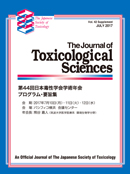The 50th Annual Meeting of the Japanese Society of Toxicology
Displaying 151-200 of 555 articles from this issue
Symposium 33: Current status and future perspectives of microphysiological system (MPS) technology
-
Session ID: S33-3
Published: 2023
Released on J-STAGE: March 08, 2024
Download PDF (3020K)
Symposium 34: JSEDR-JSOT Joint Symposium
-
Session ID: S34-1
Published: 2023
Released on J-STAGE: March 08, 2024
Download PDF (3015K) -
Session ID: S34-2
Published: 2023
Released on J-STAGE: March 08, 2024
Download PDF (3019K) -
Session ID: S34-3
Published: 2023
Released on J-STAGE: March 08, 2024
Download PDF (3020K) -
Session ID: S34-4
Published: 2023
Released on J-STAGE: March 08, 2024
Download PDF (3015K)
Symposium 35: JSCT-JSOT Joint Symposium
-
Session ID: S35-1
Published: 2023
Released on J-STAGE: March 08, 2024
Download PDF (3018K) -
Session ID: S35-2
Published: 2023
Released on J-STAGE: March 08, 2024
Download PDF (3020K) -
Session ID: S35-3
Published: 2023
Released on J-STAGE: March 08, 2024
Download PDF (3015K) -
Session ID: S35-4
Published: 2023
Released on J-STAGE: March 08, 2024
Download PDF (3015K)
Symposium 36: Environmental pollution and its toxic effects occurring “now” in developing countries
-
Session ID: S36-1
Published: 2023
Released on J-STAGE: March 08, 2024
Download PDF (3013K) -
Session ID: S36-2
Published: 2023
Released on J-STAGE: March 08, 2024
Download PDF (3020K) -
Session ID: S36-3
Published: 2023
Released on J-STAGE: March 08, 2024
Download PDF (3017K) -
Session ID: S36-4
Published: 2023
Released on J-STAGE: March 08, 2024
Download PDF (3017K) -
Session ID: S36-5
Published: 2023
Released on J-STAGE: March 08, 2024
Download PDF (3183K)
Open Symposium 1: Safety evaluation and future of organoids toward chemicals and food applications
-
Session ID: OS1-1
Published: 2023
Released on J-STAGE: March 08, 2024
Download PDF (3018K) -
Session ID: OS1-2
Published: 2023
Released on J-STAGE: March 08, 2024
Download PDF (3019K)
Open Symposium 2: Safety evaluation and its perspectives in anti viral drugs
-
Session ID: OS2-1
Published: 2023
Released on J-STAGE: March 08, 2024
Download PDF (3015K) -
Session ID: OS2-2
Published: 2023
Released on J-STAGE: March 08, 2024
Download PDF (3014K) -
Session ID: OS2-3
Published: 2023
Released on J-STAGE: March 08, 2024
Download PDF (3014K)
Open Symposium 3: New Approaches to Evaluate Bile Excretion and the Risk of Cholestasis for Human Prediction
-
Session ID: OS3-1
Published: 2023
Released on J-STAGE: March 08, 2024
Download PDF (3015K) -
Session ID: OS3-2
Published: 2023
Released on J-STAGE: March 08, 2024
Download PDF (3014K) -
Session ID: OS3-3
Published: 2023
Released on J-STAGE: March 08, 2024
Download PDF (3013K) -
Session ID: OS3-4
Published: 2023
Released on J-STAGE: March 08, 2024
Download PDF (3015K)
Open Symposium 4: Discovery toxicology strategy for New modality
-
Session ID: OS4-1
Published: 2023
Released on J-STAGE: March 08, 2024
Download PDF (3012K) -
Session ID: OS4-2
Published: 2023
Released on J-STAGE: March 08, 2024
Download PDF (3014K) -
Session ID: OS4-3
Published: 2023
Released on J-STAGE: March 08, 2024
Download PDF (3014K) -
Session ID: OS4-4
Published: 2023
Released on J-STAGE: March 08, 2024
Download PDF (3179K)
Workshop 1: Toxicology education in the field of veterinary medicine
-
Session ID: W1-1
Published: 2023
Released on J-STAGE: March 08, 2024
Download PDF (3014K) -
Session ID: W1-2
Published: 2023
Released on J-STAGE: March 08, 2024
Download PDF (3014K) -
Session ID: W1-3
Published: 2023
Released on J-STAGE: March 08, 2024
Download PDF (3019K) -
Session ID: W1-4
Published: 2023
Released on J-STAGE: March 08, 2024
Download PDF (3013K) -
Session ID: W1-5
Published: 2023
Released on J-STAGE: March 08, 2024
Download PDF (3015K)
Workshop 2: Target Safety Assessment (TSA) - Towards effective selection of drug candidate compounds -
-
Session ID: W2-1
Published: 2023
Released on J-STAGE: March 08, 2024
Download PDF (3019K) -
Session ID: W2-2
Published: 2023
Released on J-STAGE: March 08, 2024
Download PDF (3018K) -
Session ID: W2-3
Published: 2023
Released on J-STAGE: March 08, 2024
Download PDF (3016K) -
Session ID: W2-4
Published: 2023
Released on J-STAGE: March 08, 2024
Download PDF (3019K) -
Session ID: W2-5
Published: 2023
Released on J-STAGE: March 08, 2024
Download PDF (3014K)
Workshop 3: Shin-toxicity questionnaire - How to select animal species in toxicity studies
-
Session ID: W3-1
Published: 2023
Released on J-STAGE: March 08, 2024
Download PDF (3020K) -
Session ID: W3-2
Published: 2023
Released on J-STAGE: March 08, 2024
Download PDF (3020K) -
Session ID: W3-3
Published: 2023
Released on J-STAGE: March 08, 2024
Download PDF (3015K) -
Session ID: W3-4
Published: 2023
Released on J-STAGE: March 08, 2024
Download PDF (3182K)
Frontier Seminar
-
Session ID: FS
Published: 2023
Released on J-STAGE: March 08, 2024
Download PDF (3178K)
Award Lecture
-
Session ID: AWL1
Published: 2023
Released on J-STAGE: March 08, 2024
Download PDF (3018K) -
Session ID: AWL2
Published: 2023
Released on J-STAGE: March 08, 2024
Download PDF (3016K) -
Session ID: AWL3
Published: 2023
Released on J-STAGE: March 08, 2024
Download PDF (3030K) -
Session ID: AWL4
Published: 2023
Released on J-STAGE: March 08, 2024
Download PDF (3181K)
Oral Session 1
-
Session ID: O2-01
Published: 2023
Released on J-STAGE: March 08, 2024
Download PDF (3019K) -
Session ID: O2-02
Published: 2023
Released on J-STAGE: March 08, 2024
Download PDF (3017K) -
Session ID: O2-03
Published: 2023
Released on J-STAGE: March 08, 2024
Download PDF (3026K) -
Session ID: O2-04
Published: 2023
Released on J-STAGE: March 08, 2024
Download PDF (3017K)
